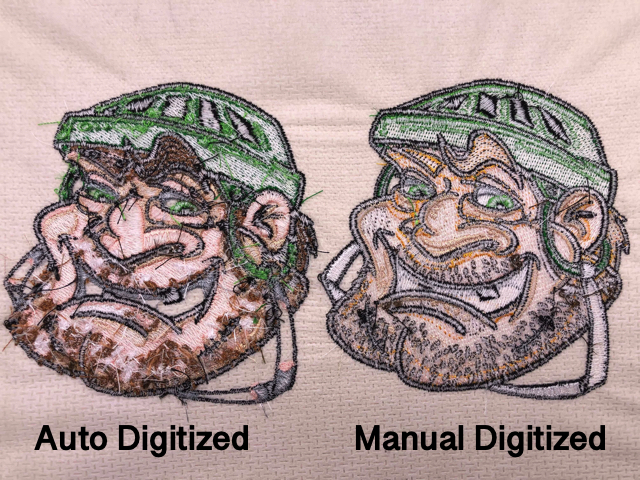Grasping the Needlework Digitizing Process: Your Ultimate Overview
Embroidery digitizing is a precise craft that needs accuracy and know-how to convert intricate designs into digital formats for device embroidery. As craftsmens begin on this journey to master the embroidery digitizing procedure, a comprehensive understanding of the essentials establishes the foundation for excellence.

Recognizing Needlework Digitizing Essentials
Needlework digitizing essentials create the structure whereupon complex styles are equated into machine-readable styles for accurate stitching. This initial step in the embroidery digitizing process is crucial for ensuring that the final embroidered item is a devoted representation of the original design. Understanding needlework digitizing essentials includes comprehending essential concepts such as stitch types, sew instructions, thickness, padding, and draw payment.
Stitch kinds play an essential function in identifying the visual and textural end result of the stitched design. By picking the proper stitch type, whether it be satin, fill, or running stitch, digitizers can achieve the wanted impact and enhance the total high quality of the embroidery. In addition, sew direction affects the flow and measurement of the style, while density establishes the spacing and insurance coverage of the stitches.
Additionally, underlay sewing offers security to the style by securing the textile and stopping distortion during the embroidery procedure. Pull payment is another essential factor to consider to combat the natural tendency of textile to agreement when stitched. Mastering these needlework digitizing fundamentals is fundamental for developing professional-quality stitched products.
Choosing the Right Digitizing Software Program
Selecting the proper digitizing software application is a crucial choice that considerably influences the efficiency and top quality of the needlework digitizing process. Digitizing for Embroidery. When picking the ideal digitizing software, it is crucial to consider aspects such as the complexity of styles you prepare to develop, the user-friendliness of the software, the level of client support used, and the compatibility with your needlework device
There are numerous digitizing software program choices offered on the market, varying from basic programs for beginners to advanced software for specialist digitizers. Some popular choices consist of Wilcom EmbroideryStudio, Hatch Embroidery Software Application, and PulseID. These software use a vast array of devices and functions to assist you produce elaborate styles with convenience.
Before choosing, it is a good idea to explore the various software application options via cost-free trials or demos to figure out which one finest fits your demands. Additionally, reading evaluations and looking for referrals from knowledgeable digitizers can supply useful understandings right into the strengths and weak points of each software program bundle (Digitizing for Embroidery). By carefully reviewing your demands and comparing the attributes of different digitizing software, you can make an enlightened choice that boosts your embroidery digitizing workflow
Digitizing Devices and Techniques

Optimizing Design Setup for Needlework
Understanding the details of layout setups is essential in accomplishing ideal lead to the embroidery digitizing procedure, structure upon the structure laid by comprehending digitizing tools and techniques. When optimizing design setups for needlework, it is essential to consider elements such as stitch type, density, underlay, pull compensation, and enrollment. Sew type selection influences the general feel and look of the layout, with alternatives like satin, fill, and running stitches using different textures and effects. Thickness describes the spacing and thickness of stitches, affecting the layout's insurance coverage and longevity. Appropriate underlay sewing supplies stability and stops material distortion, especially for intricate styles or on stretchy products. Pull settlement changes for fabric stretch throughout stitching, ensuring exact design duplication. Registration settings line up different elements of the layout accurately, keeping general design honesty. By fine-tuning these layout settings, embroiderers can boost the high quality and precision of their stitched developments.

Troubleshooting Common Digitizing Issues
When running into common digitizing problems during the needlework process, it is essential to comprehend the root triggers and apply efficient remedies immediately. One common issue is stitch thickness issues, where stitches might be also dense, creating the fabric to pucker, or also sparse, causing gaps in the design. Readjusting the stitch density settings in the digitizing software program can help solve this concern.
Another regular obstacle find is thread breaks during the embroidery process. This can take place due to different factors such as incorrect tension setups, plain needles, or using low-quality string. Making certain correct maintenance of the embroidery maker, consisting of normal needle adjustments and tension adjustments, can minimize the occurrence of string breaks.
Additionally, layout registration mistakes can result in misaligned components within the needlework style. Examining the layout alignment in the digitizing software and making required modifications prior to stitching can assist in avoiding this concern. By addressing these usual digitizing concerns promptly and effectively, you can check my reference ensure a smoother embroidery procedure and high-quality ended up items.
Conclusion
Finally, understanding the embroidery digitizing procedure requires a strong understanding of the basics, the best selection of software, and expertise of devices and methods. Enhancing style setups and fixing typical digitizing issues are essential action in making certain top notch embroidery outcomes. By complying with these actions faithfully, one can accomplish precision and performance in the digitizing process.